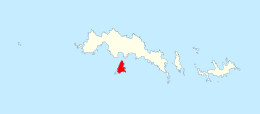 Signy Island base and panorama | |
 Location of Signy Island in the South Orkney Islands | |
| Geography | |
|---|---|
| Location | Southern Atlantic Ocean |
| Coordinates | 60°43′S 45°36′W / 60.717°S 45.600°W |
| Archipelago | South Orkney Islands |
| Total islands | 1 |
| Area | 19 km2 (7.3 sq mi) |
| Length | 6.5 km (4.04 mi) |
| Width | 5 km (3.1 mi) |
| Highest elevation | 288 m (945 ft) |
| Administration | |
| Administered under the Antarctic Treaty System | |
| Largest settlement | Signy Research Station (pop. 5) |
| Demographics | |
| Population | 5 |
| Pop. density | 0.26/km2 (0.67/sq mi) |
Signy Island is a small subantarctic island in the South Orkney Islands of Antarctica. It was named by the Norwegian whaler Petter Sørlle (1884–1933) after his wife, Signy Therese.[1]
The island is about 6.5 km (4.0 mi) long and 5 km (3.1 mi) wide and rises to 288 m (945 ft) above sea level. Much of it is permanently covered with ice. The average temperature range is 0 °C (32 °F) to about −10 °C (14 °F) in winter (i.e. in July). The extremes extend to 12 and −44 °C (53.6 and −47.2 °F). The island is separated from Coronation Island to the north by Normanna Strait, and from Moe Island to the southwest by Fyr Channel.[2][3]
On Signy Island, the British Antarctic Survey (BAS) maintains the Signy Research Station, a scientific station for research in biology. The base was opened on 18 March 1947, on the site of an earlier whaling station that had existed there in the 1920s. The station was staffed year-round until 1996; since that year it has been occupied only from November to April. It houses 10 people.[4]
- ^ "Signy Island". Geographic Names Information System. United States Geological Survey, United States Department of the Interior. Retrieved 5 May 2020.
- ^ "Normanna Strait". Geographic Names Information System. United States Geological Survey. Retrieved 5 May 2020.
- ^ "Fyr Channel". Geographic Names Information System. United States Geological Survey. Retrieved 5 May 2020.
- ^ "Who We Are". Natural Environment Research Council. Archived from the original (Web) on 6 July 2015. Retrieved 11 November 2007.
